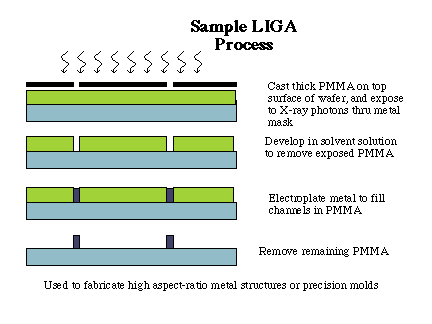LIGA Fabrication of
X-Ray Telescope Grids
LIGA is a recently introduced fabrication technology which is capable of reasonably thick (mm-cm), high aspect ratio structural fabrication. It relies on use of high energy x-rays from a synchrotron to induce damage in the molecules of a sensitive resist. After exposure to the radiation, these regions may be selectively etched by a chemical solvent, and the remaining structure may be replicated by any number of electroplating or casting processes. A cartoon illustration of a LIGA process is shown below.

This process offers the following unusual characteristics :
- Formation of structures in the cast resist layer which are 2-D replicas of the initial radiation mask. Since the absorption rate and the scattering rate for the X-rays are so low, undercutting of the initial mask is virtually unheard of.
- Capability for micron-scale lateral dimensional control in a structure which may be millimeters thick. The initial mask may be produced by high-resolution lithographic techniques. If it is sufficiently thick to absorb all radiation in the masked region, the etched sample will feature the same lateral dimensional control as the initial mask.
- Replication may be accomplished by techniques for electroplating to fill the polymer mold. Many of the details of these techniques are proprietary.
NASA is interested in the fabrication of high-aspect ratio metal microstructures for use in an X-ray telescope being planned for a solar physics mission. In this case, a modulation collimator grid is needed with metal thickness of millimeters and slots removed with width and spacing of order 20 microns. Conventional machining technologies cannot produce the required structure within tolerances for uniformity. The basic 2-D pattern is easily accomplished in an ordinary lithographic process, and LIGA offers a possibility for formation of the necessary 3-D structure.
Stanford University has one facility which is uniquely equipped for research in this area. The Stanford Synchrotron Research Laboratory offers a beamline with the highest flux of the optimal radiation for LIGA available anywhere. We are collaborating with researchers at JPL and at UC Berkeley's Advanced Light Source to fabricate the needed grid structures, and explore other opportunities for fabrication of structures which need to be made via LIGA.
As with any new fabrication technology, there are many things which can be made by LIGA, but few things which really need to be made by LIGA. We are interested in discussing possible applications of LIGA, and encourage any interested parties to consider Stanford as a potential collaboration partner in this area. We've got room on our masks to try things which might be interesting, and are at least as interested in ideas from industrial collaborators as in our own ideas.
Marcus Scholz is a graduate student in the Mechanical Engineering department who has been working on this project. You can visit his home page or send Marcus email.
Mike Hecht is the JPL Task Leader for this project. His email address is michael.h.hecht@jpl.nasa.gov. Send Mike email.
[SMSSL Home Page]
[Comments]

